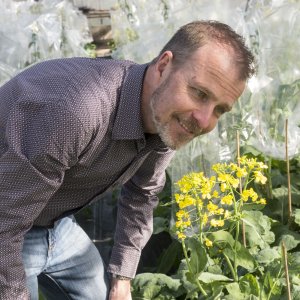Professor Lars Østergaard
Group Leader Genes in the Environment Programme Leader and Sherardian Professor of Botany at the University of Oxford Building Robustness in Crops (BRiC)
Lars studies the role of hormones in regulating plant development and diversity. Work in the Østergaard group concentrates on comparative reproductive tissue development in model plants and crop species where they aim to understand how variation in the interactions between hormonal and genetic activities has led to morphological diversity.
Whilst his previous work focussed on the Brassicaceae family, Lars recently initiated a programme on developmental genetics in Pisum (pea) to expand to an evolutionary distant family and to learn about conserved and diverse mechanisms in fruit formation.
By collaborating across a wide spectrum of disciplines, his group is keen to explore how fundamental discoveries in legumes can contribute to addressing the global requirement for increased plant-based protein production and sustainable agriculture.
The Østergaard group is developing genetic and genomic resources for Brassicaceae and Pisum research and is using both molecular genetics and functional genomics to study fruit growth.
Members of the Brassica genus include important crop plants such as oilseed rape (Brassica napus). They belong to the Brassicaceae family which also include the model plant Arabidopsis. This close evolutionary relationship between Brassica species and Arabidopsis is reflected in similar plant architecture and organ morphology.
One strand of Lars’ research takes a comparative approach using developmental genetics and computational modelling to study how fruits acquire their shape.
The cylindrical Arabidopsis fruit and the heart-shaped fruit from Capsella provides excellent model systems allowing identification of key factors and mechanisms involved.
Another strand of research in Lars’ lab aims to understand how the hormone auxin is perceived during organogenesis to regulate gene expression. In particular, they are focused on understanding a non-canonical mechanism of auxin signalling involving the auxin response factor, ETTIN.
In addition to the academic satisfaction of understanding biological processes, the knowledge acquired during studies of fruit development among Brassicaceae provides an enormous potential for knowledge transfer to improve crop performance.
Lars has already demonstrated the power of such a translational approach. Work in his group first demonstrated that the genetic control of seed dispersal is conserved across members of the Brassicaceae family. Subsequently, they used this knowledge to control this process in oilseed rape, which is known as pod shatter. Lars is focused on pursuing more of such translational opportunities.
Selected Publications
-
Ang ACH, Østergaard (2023)Save your TIRs – more to auxin than meets the eye.The New phytologistPublisher's version: 0028-646X
-
Bal M,Østergaard L (2022)Hormonal Influences on PodSeed Intercommunication during Pea Fruit DevelopmentGenes
-
Dong Y, Hu ZC, Ostergaard (2022)An optimized protocol to assess SUMOylation in the plant Capsella rubella using two-component DEX-inducible transformants.STAR protocolsPublisher's version: 2666-1667
